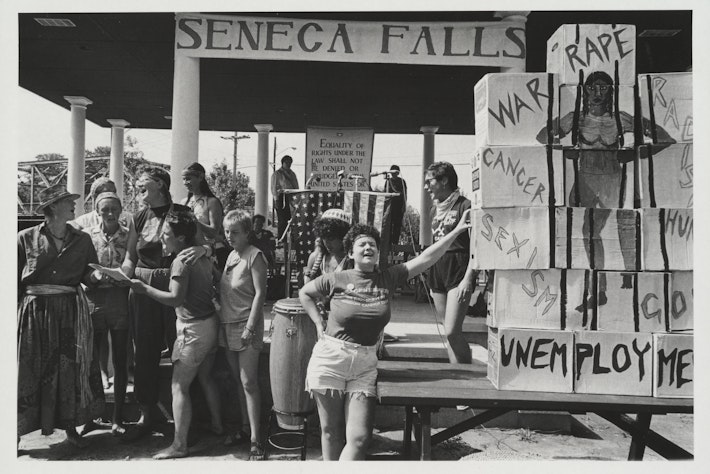Zarela: Pioneer of Regional Mexican Cuisine

Zarela Martínez is credited with bringing sophisticated regional Mexican cuisine to New York City. But she’s more than a chef and restaurateur: she has written cookbooks, hosted television shows, and developed products for a national retailer.
Zarela Martínez recalls that at the age of eight, she asked her mother why she’d given her such an unusual name. “Because it’ll look great in lights, honey,” her mother replied.
For 30 years now, since the opening of her eponymous restaurant in New York City, the name Zarela has indeed been one of the illuminated in Manhattan’s culinary scene. The Schlesinger Library recently recognized Martínez’s marquee status by acquiring her papers, which reside alongside those of Julia Child, Elizabeth David, Avis DeVoto, and M. F. K. Fisher.
Discovered by Paul Prudhomme and championed by the New York Times food editor Craig Claiborne, Martínez was part of the burgeoning American restaurant scene of the early 1980s, which included Wolfgang Puck and Alice Waters. She is credited with bringing sophisticated regional Mexican cuisine to New York City. But she’s more than a chef and restaurateur: she has written cookbooks, hosted television shows, and developed products for a national retailer.
“We’re delighted that we had the opportunity to acquire this collection—it fits well with our acquisition goals,” says Kathryn Allamong Jacob, the Johanna-Maria Fraenkel Curator of Manuscripts at the Schlesinger Library. “We really saw it as a ‘threefer’: it’s culinary; it brings an ethnic diversity not just to our food collections but to our collections in general; and it represents a woman in a nontraditional career.”
And what a rich archive it is. The 25 boxes of materials—which, with the inclusion of items belonging to her mother, Aida Gabilondo, reach back into the 1930s—document Martínez’s childhood; early career; the writing and publication of her three books, including travel diaries from her research trips; family life; personal correspondence; television appearances; product licensing; press and publicity; and much more. “My papers are so extensive,” Martínez admits. “I kept every little thing.”
All these materials—including press clippings dating back to 1981—tell a deeper story. “They really tell the history of Mexican food in the United States,” says Martínez. She agrees with the opinion expressed by Fodor’s Travel Guides about Mexican food available in the United States in those early days: it bore about as much resemblance to regional Mexican cuisine as a “howling monkey” does to a man.

Zarela Martinez with fresh produce in a grocery store in 1983. Courtesy of Schlesinger Library
For Martínez, her work has always been about more than just the food. “It’s so important to me to make my culture known and understood,” she says. Unfortunately, the high profile that Mexican food enjoys in the United States has not resulted in a greater understanding of her native culture, she says. She continues to educate the dining public with the recipes—and stories—of ordinary Mexicans: “They tell me their stories and they give me their recipes. And they always say to me, ‘
Gracias por tomarme en cuenta—Thank you for taking me into account.’”
That, she says, is what the Schlesinger Library is doing with her papers—taking Zarela Martínez into account by acknowledging her place in the American culinary landscape: “The fact that Radcliffe got this archive—it’s so emotional for me. It’s the culmination of my career.” Not that she’s slowing down: Martínez is currently hard at work on a book about naturally light Mexican food. She regularly updates her website, www.zarela.com, with recipes, videos, and personal reflections. All this while living with Parkinson’s, which she treats with a regimen of mental and physical exercise, yoga, and meditation.
“I was always ballsy,” says Martínez. “Nothing is going to get me down.” Jacob says the library looks forward to processing Zarela’s collection quickly so that this rich material about regional Mexican cuisine—and the exceptional woman who brought it to the attention of the American public—will be available to researchers.
Cook Like Zarela
Want to cook like Zarela Martínez? Try these books and television programs.
Food from My Heart
(Macmillan, 1992)
The Food and Life of Oaxaca
(Macmillan, 1997)
Zarela’s Veracruz
(Houghton Mifflin, 2001)
¡Zarela! La Cocina Veracruzana
(13 episodes, PBS, 2001)
To find out where Zarela got her love of cooking, read this book by her mother, Aida Gabilondo: Mexican Family Cooking
(Ballantine Books, 1992)
Eat Local
Zarela Martínez likes to visit her local green market for the freshest, in-season ingredients. Now that winter approaches, produce is more limited, so she recently developed several recipes for cauliflower. Here is one of those.
Cauliflower Cakes
2 cups very finely chopped cooked cauliflower (steamed or boiled)
1/2 cup finely chopped onion
1/2 cup finely chopped cilantro
1 minced jalapeño chile (optional)
1 cup grated cotija cheese (similar to feta)
2–3 tablespoons all-purpose flour
1 teaspoon salt (be careful, the cheese might be very salty)
2 eggs, beaten
Oil for frying
Combine all ingredients and let sit for about 15 minutes in the refrigerator. Form into 3-inch round patties about 1/2 inch thick. Heat the oil to rippling over medium-high heat and fry until golden on each side. Transfer to a plate or pan covered with paper towels to drain well. Serve as is or with your favorite sauce.







